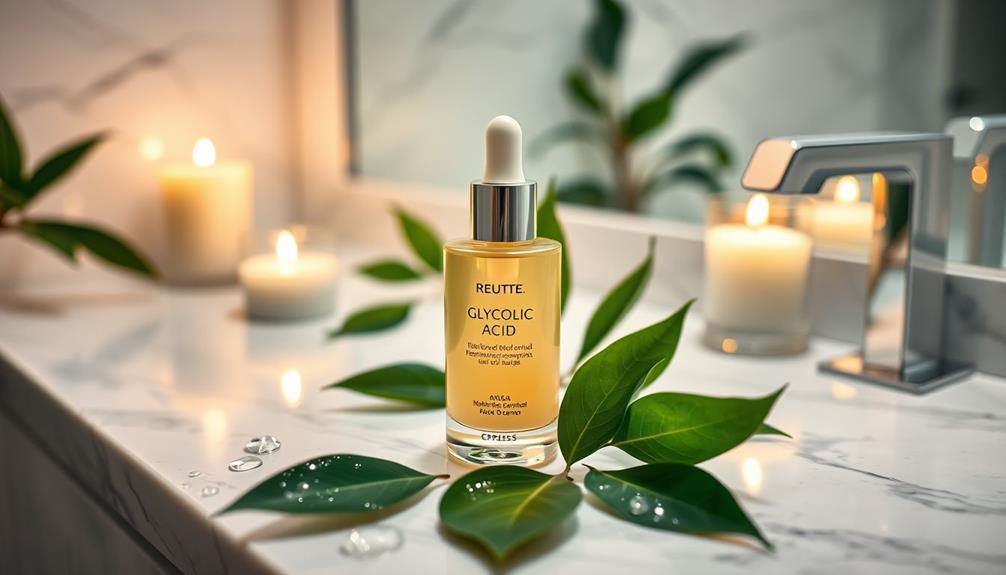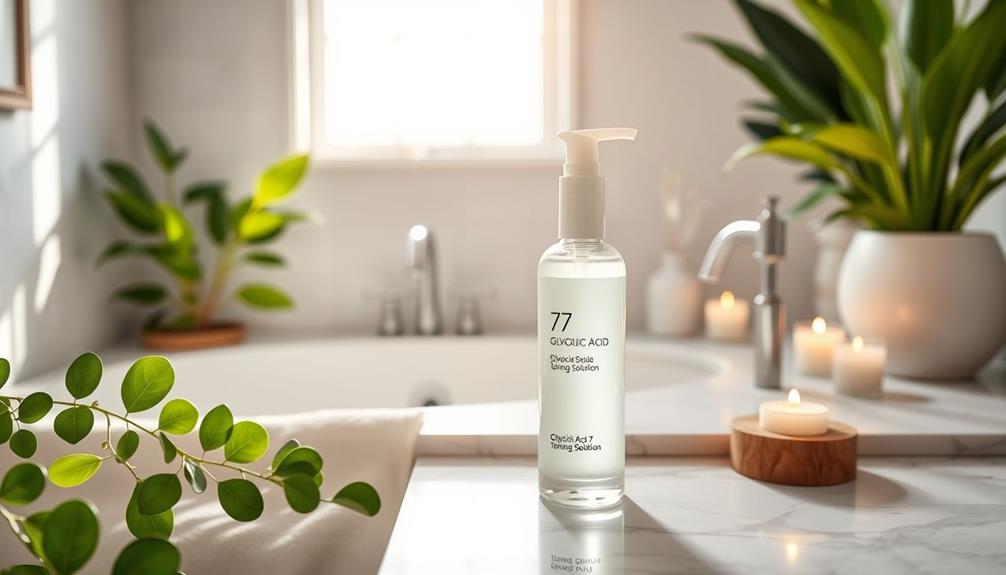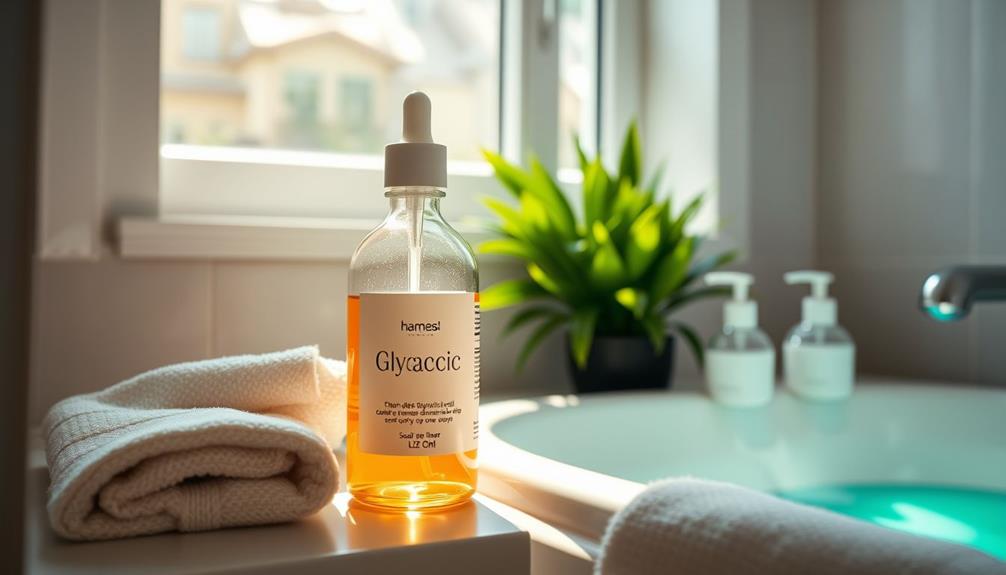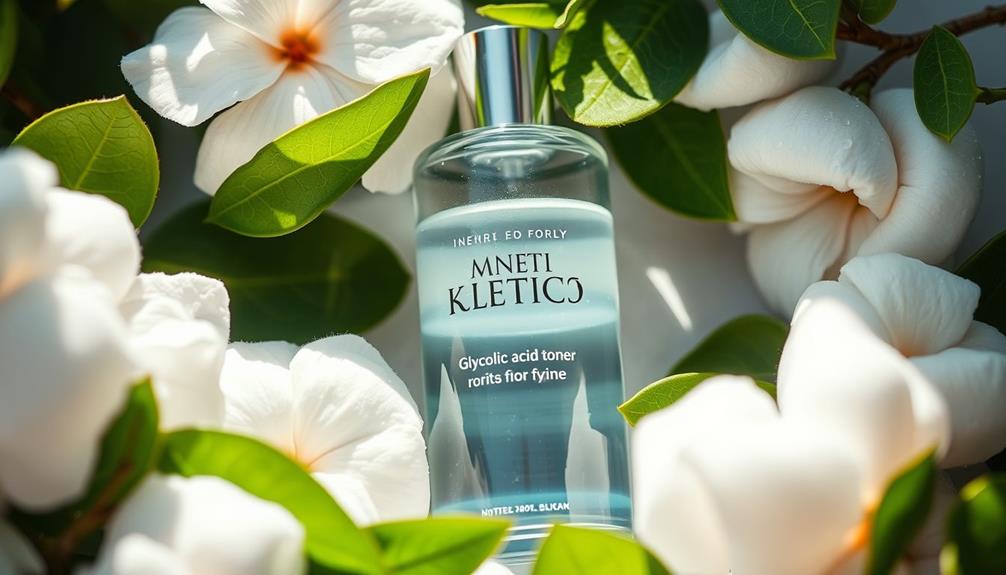Glycolic acid serum is your secret weapon for glowing skin. This powerful alpha hydroxy acid exfoliates and boosts cell turnover, helping you achieve a brighter complexion. It's suitable for all skin types, whether you have oily, dry, or mature skin. By gently removing dead skin cells, it reduces dark spots and encourages collagen production, leaving your skin firmer and more hydrated. To get the best results, start with a lower concentration and gradually increase usage. Remember to moisturize afterward and always apply sunscreen. Stick around to discover essential tips for incorporating this serum into your skincare routine.
Key Takeaways
- Glycolic acid, an alpha hydroxy acid, promotes cell turnover and exfoliates skin, resulting in a radiant and smooth complexion.
- Regular use of glycolic acid serum can reduce hyperpigmentation, dark spots, and improve overall skin tone for a more even appearance.
- The serum stimulates collagen production, enhancing skin firmness and minimizing the appearance of fine lines and wrinkles.
- Start with a lower concentration of glycolic acid, gradually increasing frequency to minimize irritation and enhance skin tolerance.
What Is Glycolic Acid?
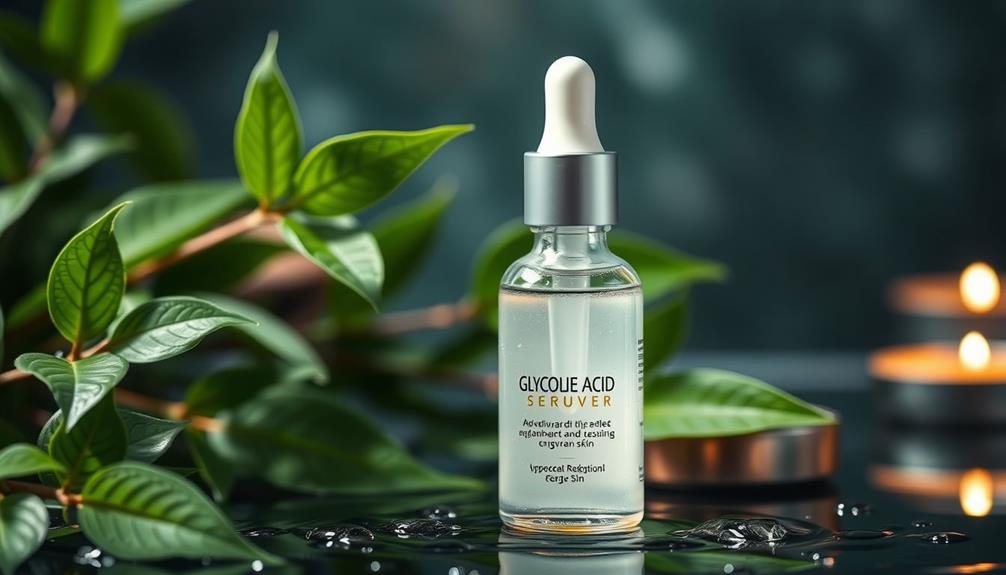
Glycolic acid is a powerful alpha hydroxy acid (AHA) derived from sugarcane that's celebrated for its ability to exfoliate and rejuvenate your skin. This potent ingredient has the smallest molecular weight among AHAs, allowing it to penetrate deeply into your skin. That makes it suitable for various skin types, including oily, acne-prone, dry, and mature skin.
Additionally, incorporating crucial oils for skin health can further enhance your skincare routine, providing natural benefits alongside glycolic acid.
Incorporating glycolic acid into your skin care routine can greatly improve your skin texture. It acts as a chemical exfoliant, effectively clearing pores and removing dead skin cells. This process enhances cell turnover, revealing a fresher, more radiant complexion.
You'll often find glycolic acid in concentrations ranging from 2% to 15%, with higher concentrations providing more intense exfoliation. However, it's important to start with lower concentrations if you have sensitive skin to avoid irritation.
Regular use of glycolic acid can lead to visible improvements, such as a smoother skin surface and a more even tone. By integrating this versatile AHA into your routine, you can access the potential for clearer, youthful-looking skin that feels rejuvenated.
Benefits of Glycolic Acid

Incorporating glycolic acid into your skincare routine offers numerous benefits, from enhancing your complexion to reducing the appearance of fine lines and uneven skin tone.
This powerful alpha hydroxy acid promotes cell turnover, gently exfoliating the skin for a fresher, more radiant look. With regular use, you'll notice a significant reduction in dark spots and hyperpigmentation, leading to a more consistent skin tone.
Additionally, maintaining a clean indoor environment can further enhance the efficacy of your skincare routine, as improved air quality reduces allergens that may irritate the skin; consider using air purifiers to support your skincare goals.
One of the standout glycolic acid benefits is its ability to stimulate collagen production. This helps improve skin firmness, minimizing the visibility of fine lines and wrinkles.
Aside from its anti-aging properties, glycolic acid acts as a humectant, attracting moisture to your skin and boosting hydration. As a result, your complexion will appear plump and healthy.
Additionally, glycolic acid helps clear pores and reduce excess oil production, making it an effective treatment for preventing and managing acne breakouts.
How Glycolic Acid Works
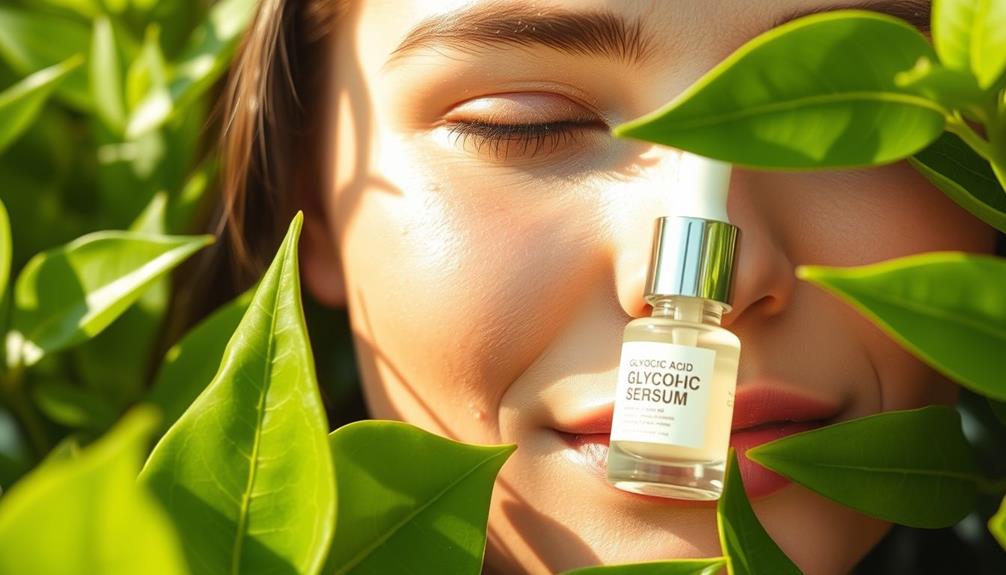
This powerful alpha hydroxy acid works by deeply penetrating the skin to promote cell turnover and effectively exfoliate, revealing a fresher, smoother complexion. Glycolic acid dissolves the bonds between dead skin cells, allowing them to be sloughed off. This process not only enhances exfoliation but also improves your skin texture by reducing fine lines and wrinkles.
Regular use of glycolic acid can lead to a more youthful appearance, as it stimulates collagen production, enhancing skin firmness and elasticity. Additionally, it helps fade dark spots and hyperpigmentation, giving you a more even skin tone.
Here's a quick comparison of the benefits of glycolic acid:
| Benefit | Description | Result |
|---|---|---|
| Exfoliation | Removes dead skin cells | Smoother complexion |
| Reduces dark spots | Fades hyperpigmentation | Even skin tone |
| Collagen production | Boosts skin firmness and elasticity | Youthful appearance |
Incorporating Glycolic Acid Into Your Routine
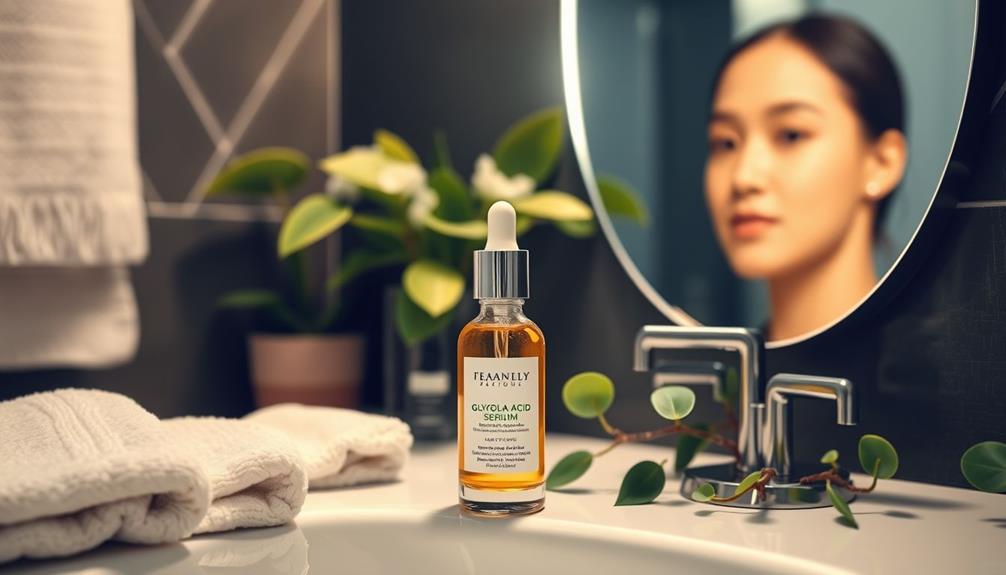
To effectively incorporate glycolic acid into your routine, start slow and gradually build your skin's tolerance.
It's crucial to maintain a consistent skincare regimen, as essential oils can enhance skin health when used in conjunction.
It's best to use glycolic acid products in the evening and always pair them with a broad-spectrum sunscreen during the day.
With consistent use, you'll notice improvements in your skin's texture and appearance.
Start Slow, Build Tolerance
Start by introducing glycolic acid into your skincare routine slowly, beginning with just once a week to see how your skin reacts.
This approach allows you to assess your skin's tolerance before gradually increasing the frequency.
Pay attention to how your skin responds; mild redness or peeling can occur during this initial period, and that's normal.
Using a glycolic acid toner, like GLOWCOLIC Resurfacing Toner, can be a gentle way to start.
It provides the benefits of exfoliation without overwhelming your skin.
Once you've established tolerance, you can shift to more concentrated formulations, such as a glycolic acid serum.
Evening Application Recommended
Applying glycolic acid serum in the evening maximizes its effectiveness while reducing the risk of sun sensitivity.
This timing allows the serum to work overnight, helping you achieve an even tone by exfoliating dead skin cells and promoting cell turnover while you sleep.
If you have sensitive skin, starting with a lower concentration is vital, as it helps you build tolerance gradually.
Before you apply the serum, always cleanse your face to guarantee deep penetration and ideal results.
After applying glycolic acid, follow up with a moisturizer to lock in hydration and support your skin barrier.
This step is fundamental, especially when using glycolic acid, as it can sometimes lead to dryness or irritation.
Pair With Sunscreen Daily
Daily sunscreen use is essential when incorporating glycolic acid into your skincare routine to protect against increased sun sensitivity.
Glycolic acid can make your skin more vulnerable to UV damage, so applying a broad-spectrum sunscreen with at least SPF 30 every morning is critical. This protects your skin from harmful rays and prevents potential irritation caused by glycolic acid.
Using sunscreen daily not only shields your skin but also helps maintain the brightening and anti-aging benefits of glycolic acid. By minimizing the formation of new dark spots and discoloration, you enhance the overall results of your skincare routine.
Remember to reapply your sunscreen every two hours, especially if you're outdoors, to guarantee continuous protection.
Pairing glycolic acid with a proper sunscreen regimen boosts collagen production and promotes a more youthful complexion. This combination combats sun-induced skin damage, allowing you to enjoy the full benefits of glycolic acid while keeping your skin radiant.
Prioritizing sunscreen is a simple yet effective way to maximize the results of your skincare efforts and achieve that sought-after glow. Don't skip this essential step in your routine!
Choosing the Right Glycolic Acid Product
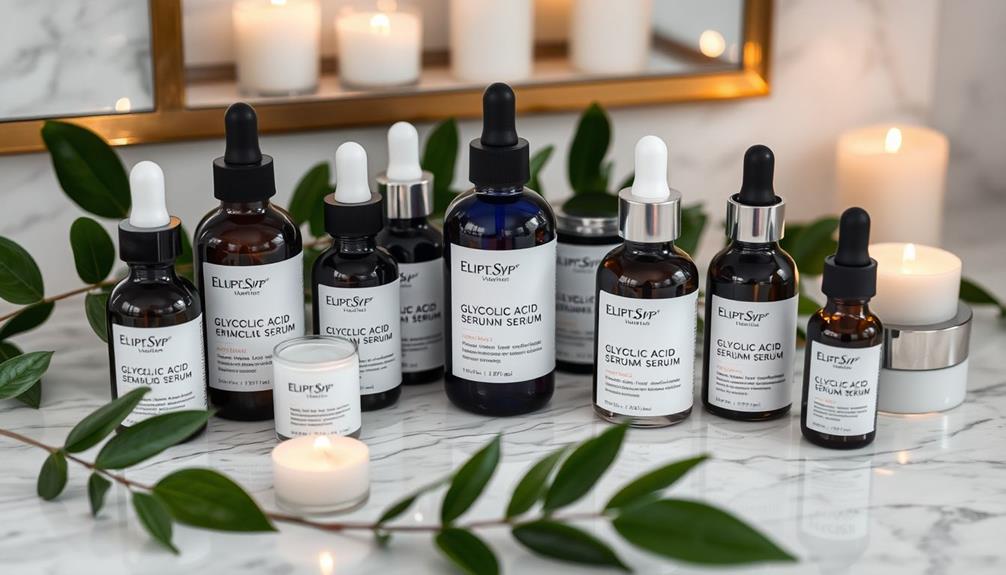
Choosing the right glycolic acid product involves considering factors like concentration, formulation, and additional ingredients to assure it suits your skin's needs.
For effective exfoliation, look for a concentration between 5-10%. This range provides the benefits of glycolic acid while minimizing irritation, especially if you're new to using such skincare products.
Next, think about the formulation type. Serums, toners, and masks all have different effects, so pick one that fits seamlessly into your routine and addresses your specific skin concerns, like uneven skin.
Also, check for additional beneficial ingredients. Products containing Vitamin E or soothing agents like Aloe can enhance hydration and help your skin feel more comfortable, countering potential irritation from glycolic acid.
Lastly, guarantee the product is dermatologist-tested, hypoallergenic, and free from parabens and sulfates, particularly if you have sensitive skin.
Start with a lower frequency—applying it once a week—and gradually increase as your skin builds tolerance. This approach helps prevent over-exfoliation, ensuring your skin feels its best without compromising its health.
Application Tips for Best Results

How can you guarantee the best results from your glycolic acid serum? Following these application tips will help you achieve glowing skin while addressing issues like hyperpigmentation and the appearance of fine lines.
- Apply the serum every night to clean, dry skin on your face and neck.
- Start with a lower concentration, gradually increasing as your skin builds tolerance.
- Always follow up with a hydrating moisturizer to combat dryness.
For ideal absorption, wait a few minutes after applying the glycolic acid serum before layering any additional products. This simple step can greatly enhance the effectiveness of your skin routine.
Remember, consistency is key! Regular use will help you see improvements in your skin's texture and tone over time.
If you experience mild redness or peeling initially, don't worry; this is normal as your skin adjusts.
Potential Side Effects and Precautions

Using glycolic acid serum can lead to mild redness or peeling, especially as your skin adjusts to the treatment. This is particularly common for those with skin sensitivity. To minimize potential side effects, start with a lower concentration and apply it less frequently. Gradually increase usage as your skin builds tolerance to avoid irritation.
One crucial precaution you shouldn't overlook is sunscreen application. Glycolic acid can increase your skin's sensitivity to the sun, making it essential to protect your skin from UV damage during the day. Apply a broad-spectrum sunscreen with at least SPF 30 to shield your skin and prevent adverse reactions.
If you have pre-existing skin conditions or sensitivities, it's wise to consult a dermatologist before adding glycolic acid to your routine. They can provide personalized advice and help you navigate potential side effects.
Lastly, keep a close eye on your skin's response after application. Monitoring skin response allows you to identify any adverse reactions early on, ensuring your skincare routine remains effective and safe.
Glycolic Acid for Different Skin Types

Glycolic acid can benefit all skin types, but adjusting the concentration based on your individual tolerance is essential for ideal results. Here's how you can tailor its use to your skin type:
- Oily and Acne-Prone Skin: Glycolic acid helps unclog pores and reduces excess oil, making it effective for preventing breakouts.
- Dry Skin: Its humectant properties attract moisture, maintaining hydration while promoting cell turnover.
- Sensitive Skin: Start with lower concentrations and perform patch tests to minimize irritation, gradually increasing frequency as your skin adjusts.
No matter your skin type, incorporating glycolic acid into your routine can lead to glowing skin. Just remember to monitor how your skin reacts and adjust accordingly.
You'll find that with the right concentration and application, glycolic acid can enhance your skin's texture and overall appearance, giving you the radiant look you desire.
Expert Recommendations for Glowing Skin

Experts advise starting with a glycolic acid serum containing 5-10% concentration to build tolerance while effectively enhancing your skin's glow. Incorporating this serum into your nightly skincare routine helps exfoliate, unclog pores, and improve the absorption of other products. Begin by using it 2-3 times a week, gradually increasing the frequency based on how your skin responds to minimize irritation.
To maximize benefits, protect your skin from sun sensitivity by applying a broad-spectrum sunscreen with at least SPF 30 during the day. Regular use can considerably reduce the appearance of hyperpigmentation, improve skin texture, and boost radiance. Many users notice visible improvements within 4-6 weeks of consistent application.
Here's a quick reference table for your skincare routine:
| Step | Product Type | Frequency |
|---|---|---|
| Cleansing | Gentle Cleanser | Daily |
| Exfoliation | Glycolic Acid Serum | 2-3 times a week |
| Moisturizing | Hydrating Moisturizer | Daily |
Frequently Asked Questions
Does Glycolic Acid Make Your Skin Glow?
Yes, glycolic acid can make your skin glow. It exfoliates dead cells, promotes cell turnover, and stimulates collagen production, resulting in a brighter, more radiant complexion that feels soft and looks even-toned with regular use. In addition to making your skin glow, the benefits of glycolic acid peel also include reducing the appearance of fine lines and wrinkles, minimizing the appearance of pores, and improving overall skin texture. This powerful ingredient can also help to fade dark spots and hyperpigmentation, resulting in a more even and youthful-looking complexion. With its ability to penetrate deeply into the skin, glycolic acid effectively targets and treats various skin concerns, making it a popular choice for those looking to achieve a more radiant and rejuvenated appearance.
How Long Does It Take for Glycolic Acid to Brighten Skin?
It typically takes 2 to 4 weeks for glycolic acid to start brightening your skin. With consistent use, you'll notice even more significant improvements in tone and texture after 4 to 6 weeks.
Does Glycolic Acid Serum Lighten Skin?
Studies show that 80% of users notice a brighter complexion within four weeks. Yes, glycolic acid serum can lighten skin by fading dark spots and improving your overall skin tone with consistent use and proper sun protection.
Can I Use Glycolic Acid Serum Every Day?
Yes, you can use glycolic acid serum every day, but start slow. Gradually increase frequency based on how your skin reacts. Always remember to apply sunscreen during the day to protect your skin.
Conclusion
Incorporating glycolic acid into your skincare routine is like planting seeds for a vibrant garden.
With its exfoliating power and skin-rejuvenating benefits, you're on your way to achieving that coveted glow.
Just remember to choose the right product, apply it correctly, and listen to your skin.
With patience and care, you'll cultivate a radiant complexion that shines bright.
So go ahead and release the beauty that awaits you with glycolic acid!
